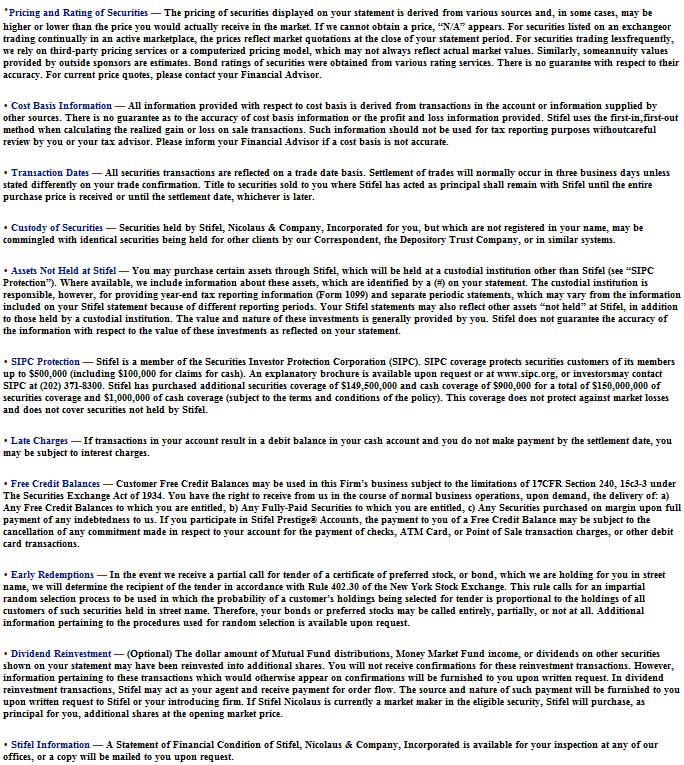|
ROLLOVER
CENTER |
| |
|
| |
STIFEL NICOLAUS |
| |
|
|
Investment StrategistTM
December 2008
Year-End Financial Strategies
It�s hard to believe that another year will
soon be coming to an end. In the weeks to come, you�ll likely
be busy preparing for the holidays and winter months ahead.
Despite the hectic pace this time of year, it�s important to
take time to make an assessment of your financial situation
and look into implementing strategies before the end of the
year that could potentially benefit you during tax season.
Schedule a Year-End Review
The end of the year is a great time to schedule a meeting with
your Stifel Financial Advisor and your tax professional to
talk about your current financial situation and help ensure
that the plans you have in place are suitable to help you meet
your goals.
Recent market volatility may
have significantly impacted your target asset allocations.
Revisit your original objectives and analyze your portfolio
with your Stifel Financial Advisor to see if any changes need
to be made. You�ll also want to determine whether or not now
would be a good time to sell underperforming investments or
capitalize on assets that have performed well for you. Either
scenario will have tax implications that you will want to
discuss with your tax professional. |
 |
Establish and/or Contribute to
an IRA
You can contribute up to $5,000 to an
IRA in 2008, and if you�re over age 50, you can make an additional
�catch-up� contribution of $1,000 for a total of $6,000. Your Stifel
Financial Advisor can help you determine whether a traditional or Roth
IRA is best for your unique situation.
Also, if you�ve recently retired or
changed jobs and still have money in your previous employer�s
retirement plan, consider rolling over those retirement dollars into
an IRA to continue tax-deferred growth while potentially gaining
access to a greater number of investment options.
Take Required Minimum
Distributions
Individuals in traditional, SEP,
SIMPLE IRAs, and Qualified Retirement Plans must take Required Minimum
Distributions (RMDs) by April 1 of the year following the year they
turn 70 1/2. An exception to the rule exists for participants in
Qualified Retirement Plans who are continuing to work and don�t own
more than 5% of the company. Generally, these participants can delay
their RMDs until April 1 following the year of retirement. If this
situation applies to you, contact your human resources benefits
specialist for proper guidance.
If you turned 70 1/2 this year, you
are in your first Required Beginning Date phase and must decide when
to take your first RMD. You can take it by December 31 this year or
delay the first payment until April 1, 2009. However, if delaying the
first (2008) payment, you must also take your second RMD (2009) by
December 31 in that same year. It�s
|
V i s i o n
�
P l a n n
i n g
�
F o c u s |
|
SNINS110801 |
Year-End Financial Strategies
|
|
|
|
your choice to take one taxable RMD
this year or take two in 2009. All subsequent RMDs must be taken by
December 31 each year.
For those already in their RMD payout
phase, distributions must continue each year. If an RMD is overlooked
or underpaid, a 50% penalty will be due on the unpaid portion for the
year.
RMD calculations are based on a factor
from the Uniform Life Expectancy tax table. The only exception is if
an IRA holder appoints his or her spouse as sole primary beneficiary
and that spouse is more than 10 years younger than the IRA holder. In
this case, the IRA holder and the spouse�s actual age are used to
determine an annual factor from the �Joint and Last Survivor Table.�
To calculate an RMD, the IRA holder
simply divides the previous year�s December 31 IRA balance by the life
expectancy factor from the Uniform Life Expectancy tax table. Your
Stifel Financial Advisor can assist you in calculating your RMD on
your Stifel IRA.
If you have multiple IRAs, the IRS
requires that the IRA balances are aggregated to determine a year�s
RMD.
An IRA owner must tally the December
31 value of all IRAs and take the combined total RMD from one or more
of the IRAs. If one of these IRAs is overlooked, the 50% penalty will
be due on the neglected amount. For this reason, it makes sense to
consolidate your IRAs with Stifel should you have any held
with other firms.
It�s important to note that IRA
balances cannot be aggregated with qualified retirement plan balances
to determine an RMD. RMDs for IRAs and qualified retirement plans must
be satisfied independently.
Convert to a Roth IRA
If you qualify, you may want to
consider converting your traditional IRA to a Roth IRA. This option is
currently available to anyone whose tax filing status is single,
married filing jointly, or head of household and whose adjusted gross
income is $100,000 or less. If you file as married filing separately
and/or make more than $100,000, you are not eligible to convert to a
Roth IRA. Starting in 2010, however, everyone will have the
opportunity to convert to a Roth, regardless of income.
Unlike with traditional IRAs, there
are no required minimum distributions for Roth IRAs. Also, assuming
the same gross contribution, a Roth IRA enables most savers to amass a
greater nest egg, because (assuming that certain conditions are met)
withdrawals from earnings during retirement are income tax-free. It is
important to consider, however, that conversion is a taxable event and
the income generated is considered ordinary income. However, if you
are eligible, you may be able to use the current bear market to your
advantage. By converting devalued securities now, you would pay less
income tax than you would when the market was at its peak, and with a
Roth, you will have the potential to recoup your losses on a tax-free
basis.
|
 |
Consider Making Gifts
If you�re looking to reduce the
taxable value of your estate, you can give up to the annual
exclusion amount � $12,000 in 2008 � to any number of people
without having to pay gift taxes and without the recipient owing
income tax on the gifts.
The end of the year is also a good
time to make charitable donations for a tax write-off. If you have
a stock that has appreciated in value, it may make sense to donate
the appreciated stock, since you will receive a tax deduction for
the market value of the stock while avoiding having to pay capital
gains on the sale of the stock.
|
Thanks to the Pension Protection Act
of 2006, certain IRA holders have the opportunity to donate assets in
their IRA to qualified charitable organizations. If it�s done
correctly, the distributions are tax-free. The provision applies for
traditional and Roth IRAs and does not typically apply to
distributions from active SEP or SIMPLE IRAs unless an employer
contribution was not made to the SEP or SIMPLE IRA during or for the
year the charitable distributions are made. To qualify, IRA holders
must be at least 70 � years of age on or before the actual day the
donation is made.

-
For those who do qualify by age, their
maximum IRA charitable donation is limited to $100,000 per tax year.
Any distributions in excess of this limit will not qualify for the tax
exclusion benefit and will be treated as ordinary income. Note that
distributions of base contributions and tax-paid conversions to Roth
IRA holders are generally not considered taxable income.
Amounts of up to $100,000 sent
directly to a qualified charity on behalf of an eligible traditional
IRA holder will count toward satisfying that individual�s RMD for the
year.
For information pertaining to
qualified charities, go to the IRS web site, www.irs.gov/individuals,
and review the �Charities and Non-Profits� section.
|
Set Aside Money for Your
Children�s Education
A 529 College Savings Plan offers
a powerful way to save for a child�s future educational expenses.
With a 529 College Savings Plan, assets grow tax-deferred, just
like in a 401(k) plan or a traditional IRA. In addition,
distributions for qualified education expenses will be free from
federal tax. Investors utilizing a 529 College Savings Plan should
know that non-qualified withdrawals are taxable as ordinary income
to the extent of earnings and may also be subject to a 10 percent
Federal income tax penalty. State tax treatment may differ.
Investors should discuss their particular tax situation with a tax
professional.
Individuals of all income levels
can open a 529 College Savings Plan, and multiple plans may be
opened for different beneficiaries. There are generally no age or
time limit restrictions for the participant or the beneficiary.
This allows grandparents or other relatives to contribute to the
beneficiary�s education without being penalized.
|

|
529 College Savings Plans can
provide significant benefits in the area of estate planning as well.
Contributions are considered a completed gift and are removed from the
donor�s estate, provided the donor lives beyond the number of years
for which the gifts were pre-funded. The plan allows an investor to
contribute a lump sum of up to five times the annual gift exclusion
($12,000) in a single year, with no gift tax due on the transfer. This
amount (up to $60,000 or $120,000 for married couples) may be
contributed to as many 529 College Savings Plans as you desire,
provided there is a separate beneficiary for each account and no other
gifts are made to that beneficiary, either directly or through a
College Savings Plan, for five years.
Investors should consider
carefully the investment objectives, risks, and charges and expenses
associated with a 529 College Savings Plans before investing or
sending money. The official program offering statement, which includes
information on municipal fund securities, is available from your
Financial Advisor and should be read carefully before investing.
The value of a 529 College Savings
account may fluctuate, and there is no guarantee that any investment
portfolio will achieve the stated goal. Your investment may be worth
more or less than its original value.
Optimize Flexible Spending
Accounts
If your employer offers a flexible
spending account, consider taking advantage of this unique benefit.
With a flexible spending account, funds are taken from your paycheck
on a pre-tax basis, reducing your taxable income. The money is
refunded to you upon submitting a claim to your benefits department or
benefits provider. There are two kinds of flexible spending accounts �
health care and dependent care � and up to $5,000 can be contributed
to each account. If you decide to contribute to a flexible spending
account, it�s important to familiarize yourself with the specific
types of expenses that are eligible for reimbursement and to not
contribute more than you will use, since these accounts come with a
�use it or lose it� rule.
Preparing for 2009
Your Stifel Financial Advisor can work
in tandem with your tax professional to help determine which of these
strategies could potentially assist you in reducing the amount of
taxes you pay while helping you reach your financial goals. But don�t
procrastinate � time is of the essence. Contact your Stifel Financial
Advisor today!

 Stifel, Nicolaus & Company, Incorporated
� Member SIPC and New York
Stock Exchange
� One
Financial Plaza, 501 North Broadway, St. Louis, Missouri 63102
� www.stifel.com
|
|
|




